
Stupa
Encyclopedia
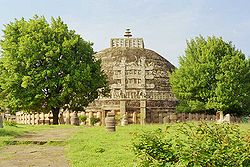

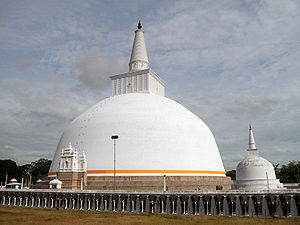
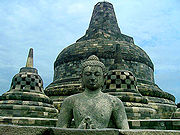
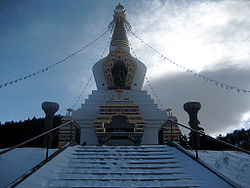
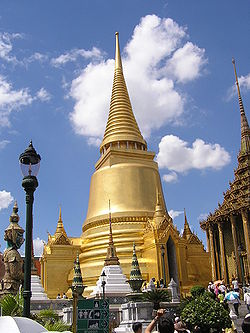
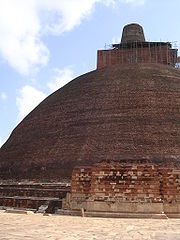
After "stupa", "chorten" is the most commonly encountered English term. The term "reliquary
Reliquary
A reliquary is a container for relics. These may be the physical remains of saints, such as bones, pieces of clothing, or some object associated with saints or other religious figures...
" is sometimes used, after a Roman Catholic functional equivalent.
Stupas are an ancient form of mandala
Mandala
Maṇḍala is a Sanskrit word that means "circle". In the Buddhist and Hindu religious traditions their sacred art often takes a mandala form. The basic form of most Hindu and Buddhist mandalas is a square with four gates containing a circle with a center point...
.
Description and history
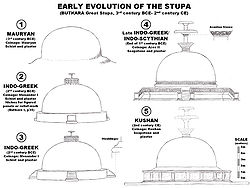
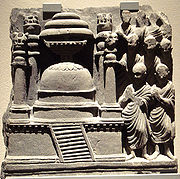
Relic
In religion, a relic is a part of the body of a saint or a venerated person, or else another type of ancient religious object, carefully preserved for purposes of veneration or as a tangible memorial...
s of the Buddha
Gautama Buddha
Siddhārtha Gautama was a spiritual teacher from the Indian subcontinent, on whose teachings Buddhism was founded. In most Buddhist traditions, he is regarded as the Supreme Buddha Siddhārtha Gautama (Sanskrit: सिद्धार्थ गौतम; Pali: Siddhattha Gotama) was a spiritual teacher from the Indian...
(cetiya
Cetiya
The cetiya, "reminders" or "memorials" , are objects and places used by Theravada Buddhists to remember Gautama Buddha. These are traditionally divided into three categories: śarīraka, pieces of the body, paribhogaka, things he used, and udeśaka, reminders...
). After the parinirvana
Parinirvana
In Buddhism, parinirvana is the final nirvana, which occurs upon the death of the body of someone who has attained complete awakening...
of the Buddha, his remains were cremated and the ashes divided and buried under eight stupas with two further stupas encasing the urn and the embers. Little is known about these early stupas, particularly since it has not been possible to identify the original ten monuments. However, some later stupas, such as at Sarnath
Sarnath
Sarnath or Sārnātha is the deer park where Gautama Buddha first taught the Dharma, and where the Buddhist Sangha came into existence through the enlightenment of Kondanna. Sarnath is located 13 kilometres north-east of Varanasi, in Uttar Pradesh, India...
and Sanchi
Sanchi
Sanchi is a small village in Raisen District of the state of Madhya Pradesh, India, it is located 46 km north east of Bhopal, and 10 km from Besnagar and Vidisha in the central part of the state of Madhya Pradesh. It is the location of several Buddhist monuments dating from the 3rd...
, seem to be embellishments of earlier mounds.
Features of a stupa
1. Harmika-It is built on the top of the oval shaped stupa.
2. Medhi-It is an elevated circular path around the stupa used for Pradhikshina
3. Toran-It is the Gateway to the stupa.
4. Vedica-It is a railing meant for the protection of the holy place.
In the third century BC, after his conversion to Buddhism, the emperor Asoka had the original stupas opened and the remains distributed among the several thousand stupas he had built. Nevertheless, the stupas at the eight places associated with the life of the Buddha continued to be of particular importance. Accordingly, the importance of a stupa changed from being a funerary monument to being an object of veneration. As a consequence their appearance changed also. Stupas were built in Sri Lanka
Sri Lanka
Sri Lanka, officially the Democratic Socialist Republic of Sri Lanka is a country off the southern coast of the Indian subcontinent. Known until 1972 as Ceylon , Sri Lanka is an island surrounded by the Indian Ocean, the Gulf of Mannar and the Palk Strait, and lies in the vicinity of India and the...
soon after King Devanampiyatissa converted to Buddhism, the first stupa to be built was the Thuparamaya
Thuparamaya
Thuparamaya is a dagoba in Anuradhapura, Sri Lanka. It is a Buddhist sacred place of veneration.Mahinda Thera, an envoy sent by King Ashoka himself introduced Theravada Buddhism and also chetiya worship to Sri Lanka. At his request King Devanampiyatissa built Thuparamaya in which was enshrined the...
. Later on Sri Lanka went on to build many stupas over the years, some like the Jetavanarama in Anuradhapura
Anuradhapura
Anuradhapura, , is one of the ancient capitals of Sri Lanka, famous for its well-preserved ruins of ancient Lankan civilization.The city, now a UNESCO World Heritage Site, lies 205 km north of the current capital Colombo in Sri Lanka's North Central Province, on the banks of the historic...
being one of the tallest ancient structures in the world. Sri Lanka also boasts construction of stupas, which have used most advanced engineering techniques and knowledge, for example the use of 'lightning conductors' and 'special shelters (vatadage
Vatadage
Vatadage is a type of Buddhist structure found in Sri Lanka. It also known as dage, thupagara, and cetiyagara. Although it may have had some Indian influence, it is a structure that is more or less unique to ancient Sri Lankan architecture. Vatadages were built around small stupas for their...
)', which is the reason they have been standing undamaged for thousands of years.
Ghalegay
Ghalegay
Ghalegay is a valley located 12km south of Mingora, Khyber Pakhtunkhwa, situated on the eastern side of Swat River. It is one of the main villages lying between the two cities, Mingora and Barikot....
hosts one of the biggest stupas at Mohallah Singardar in district Swat, Pakistan.
They evolved into large hemispherical mounds with features such as the torana
Torana
For the Australian car, see Holden Torana.A torana is a type of gateway seen in the Hindu and Buddhist architecture of the Indian subcontinent.-Meaning and uses of torana:...
(gateway), the vedica (fence-like enclosure evolved from the vedic villages), the harmika (a square platform with railings on top of the stupa), chattrayashti (the parasol or canopy) and a circumambulatory
Circumambulation
Circumambulation is the act of moving around a sacred object.Circumambulation of temples or deity images is an integral part of Hindu ritual. It is also practised in Buddhism. In Islam, circumambulation is performed around the Kaaba in Mecca, in a counter-clockwise direction...
around the stupa. From the third century BC onwards, stupas were incorporated into the hall of the chaitya
Chaitya
A chaitya is a Buddhist or Jain shrine including a stupa. In modern texts on Indian architecture, the term chaitya-griha is often used to denote assembly or prayer hall that houses a stupa.-History:...
-griha.
One such stupa was discovered at Sopara
Sopara
Sopara or Soparaka was an ancient port town and the capital of the ancient Aparanta. The site of this ancient town is located near the present day Nala Sopara town in the Thane district of the state Maharashtra, India.Nala Sopara is one of the busiest western suburbs of Mumbai city...
, an ancient port near Mumbai
Mumbai
Mumbai , formerly known as Bombay in English, is the capital of the Indian state of Maharashtra. It is the most populous city in India, and the fourth most populous city in the world, with a total metropolitan area population of approximately 20.5 million...
, and is believed to be one of the most ancient stupas in the world. The oldest known stupa is the Dhamek Stupa
Dhamek Stupa
Dhamek Stupa is a massive stupa located at Sarnath, 13 km away from Varanasi in the state of Uttar Pradesh, India....
at Sarnath
Sarnath
Sarnath or Sārnātha is the deer park where Gautama Buddha first taught the Dharma, and where the Buddhist Sangha came into existence through the enlightenment of Kondanna. Sarnath is located 13 kilometres north-east of Varanasi, in Uttar Pradesh, India...
, India
India
India , officially the Republic of India , is a country in South Asia. It is the seventh-largest country by geographical area, the second-most populous country with over 1.2 billion people, and the most populous democracy in the world...
, while the tallest is the Phra Pathom Chedi
Phra Pathom Chedi
Phra Pathom Chedi is the tallest stupa in the world with the height of . It is located in the town of Nakhon Pathom, Thailand.The name Phra Pathom Chedi means Holy chedi of the beginning. The stupa at the location is first mentioned in Buddhist scriptures of the year 675, however archaeological...
in Nakhon Pathom
Nakhon Pathom Province
Nakhon Pathom ) is one of the central provinces of Thailand. Neighboring provinces are Suphan Buri, Ayutthaya, Nonthaburi, Bangkok, Samut Sakhon, Ratchaburi and Kanchanaburi...
, Thailand
Thailand
Thailand , officially the Kingdom of Thailand , formerly known as Siam , is a country located at the centre of the Indochina peninsula and Southeast Asia. It is bordered to the north by Burma and Laos, to the east by Laos and Cambodia, to the south by the Gulf of Thailand and Malaysia, and to the...
, at a height of 127 metres. The most elaborate stupa is the 8th century Borobudur
Borobudur
Borobudur, or Barabudur, is a 9th-century Mahayana Buddhist monument near Magelang, Central Java, Indonesia. The monument comprises six square platforms topped by three circular platforms, and is decorated with 2,672 relief panels and 504 Buddha statues...
monument in Java
Java
Java is an island of Indonesia. With a population of 135 million , it is the world's most populous island, and one of the most densely populated regions in the world. It is home to 60% of Indonesia's population. The Indonesian capital city, Jakarta, is in west Java...
, Indonesia
Indonesia
Indonesia , officially the Republic of Indonesia , is a country in Southeast Asia and Oceania. Indonesia is an archipelago comprising approximately 13,000 islands. It has 33 provinces with over 238 million people, and is the world's fourth most populous country. Indonesia is a republic, with an...
. The upper rounded terrace with rows of bell shaped stupas contained buddha images symbolizing Arupadhatu
Arupajhana
In Buddhism, the arūpajhānas or "formless meditations" are four successive levels of meditation on non-material objects. These levels are higher than the rūpajhānas, and harder to attain...
, the sphere of formlessness. The main stupa itself is empty, symbolizing complete perfection of enlightenment. The main stupa is only the crown part of the monument, while the base is pyramidal structure elaborate with galleries adorned with bas relief of scenes derived from Buddhist text depicted the life of Siddharta Gautama. Borobudur unique and significant architecture has been acknowledge by UNESCO as the largest buddhist monument in the world. According to Brahmi
Brāhmī script
Brāhmī is the modern name given to the oldest members of the Brahmic family of scripts. The best-known Brāhmī inscriptions are the rock-cut edicts of Ashoka in north-central India, dated to the 3rd century BCE. These are traditionally considered to be early known examples of Brāhmī writing...
, kharoshti , Pali
Páli
- External links :* *...
and Sanskrit
Sanskrit
Sanskrit , is a historical Indo-Aryan language and the primary liturgical language of Hinduism, Jainism and Buddhism.Buddhism: besides Pali, see Buddhist Hybrid Sanskrit Today, it is listed as one of the 22 scheduled languages of India and is an official language of the state of Uttarakhand...
edicts Ashoka the great founded 84,000 stupas all over the south Asia.
The stupa evolved into the pagoda
Pagoda
A pagoda is the general term in the English language for a tiered tower with multiple eaves common in Nepal, India, China, Japan, Korea, Vietnam and other parts of Asia. Some pagodas are used as Taoist houses of worship. Most pagodas were built to have a religious function, most commonly Buddhist,...
as Buddhism spread to other Asian countries. The pagoda has varied forms that also include bellshaped and pyramidal ones. Today, in the Western context, there is no clear distinction between the stupa and the pagoda. But in general stupa is used for a Buddhist structure of India or south-east Asia, while pagoda refers to a building in east Asia
East Asia
East Asia or Eastern Asia is a subregion of Asia that can be defined in either geographical or cultural terms...
which can be entered and which may be secular in purpose.
Symbolism
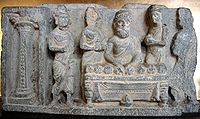
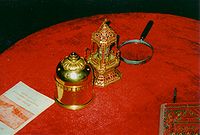
Five purified elements
Although not described in any Tibetan text on stupa symbolism, the stupa may represent the five purified elements:- The square base represents earth
- The hemispherical dome/vase represents water
- The conical spire represents fire
- The upper lotus parasol and the crescent moon represents air
- The sun and the dissolving point represents the element of space
Construction
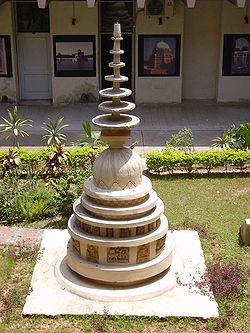
Dharma transmission
Dharma transmission refers to "the manner in which the teaching, or Dharma, is passed from a Zen master to their disciple and heir...
and ceremonies from a Buddhist teacher
Lama
Lama is a title for a Tibetan teacher of the Dharma. The name is similar to the Sanskrit term guru .Historically, the term was used for venerated spiritual masters or heads of monasteries...
is necessary. Which kind of Stupa to be constructed in a certain area is decided together with the teacher assisting in the construction. Sometimes the type of stupa chosen is directly connected with events that have taken place in the area.

Treasury
All stupas contain a treasury filled with various objects. Small offerings called Tsa-Tsas fill a major part of the treasury. Creation of various types of Tsa-Tsas is a ceremony itself. Mantras written on paper are rolled into thin rolls, and put into these small clay stupas. Filling the treasury, one layer of Tsa-Tsas are placed, and the empty space between is filled with dry sand. On the new surface appearing, another layer is made, until the entire space of a treasury is full.The number of Tsa-Tsas are dependent on the size of both the treasury and Tsa-Tsa, since it should be completely filled. For example, the Kalachakra stupa
Kalachakra stupa
In Buddhism, a Kalachakra stupa is a stupa whose symbolism is not connected to events in the Buddha's life, but instead to the symbolism of the Kalachakra Tantra, created to protect against negative energies...
in southern Spain
Spain
Spain , officially the Kingdom of Spain languages]] under the European Charter for Regional or Minority Languages. In each of these, Spain's official name is as follows:;;;;;;), is a country and member state of the European Union located in southwestern Europe on the Iberian Peninsula...
has approximately 14 000 Tsa-Tsas within.
Jewellery
Jewellery
Jewellery or jewelry is a form of personal adornment, such as brooches, rings, necklaces, earrings, and bracelets.With some exceptions, such as medical alert bracelets or military dog tags, jewellery normally differs from other items of personal adornment in that it has no other purpose than to...
and other "precious" objects are also placed in the treasury. It is not necessary that the jewellery be expensive, since it is the symbolic value that is important, not the market price. It is believed that the more objects placed into the stupa, the stronger the energy of the Stupa will be.
Tree of Life
A very important element in every Stupa is the Tree of Life. It is a wooden pole covered with gems and thousands of mantras, and placed in the central channel of the stupa. It is placed here during a ceremony or initiation, where the participants hold colorful ribbons connected to the Tree of Life. Together the participants make their most positive and powerful wishes, which are stored in the Tree of Life. In this way the stupa is charged up, and will start to function.Benefits
Building a stupa is considered extremely beneficial, leaving very positive karmicKarma in Buddhism
Karma means "action" or "doing"; whatever one does, says, or thinks is a karma. In Buddhism, the term karma is used specifically for those actions which spring from the intention of an unenlightened being.These bring about a fruit or result Karma (Sanskrit, also karman, Pāli: Kamma) means...
imprints in the mind. Future benefits from this action will result in fortunate rebirths. Fortunate worldly benefits will be the result, such as being born into a rich family, having a beautiful body, a nice voice, and being attractive and bringing joy to others and having a long and happy life, in which one's wishes are fulfilled quickly. On the absolute level, one will also be able to reach enlightenment
Enlightenment (spiritual)
Enlightenment in a secular context often means the "full comprehension of a situation", but in spiritual terms the word alludes to a spiritual revelation or deep insight into the meaning and purpose of all things, communication with or understanding of the mind of God, profound spiritual...
, the goal of Buddhism, quickly.
Destroying a stupa on the other hand, is considered an extremely negative deed, similar to killing. Such an action is explained to create massive negative karmic
Karma in Buddhism
Karma means "action" or "doing"; whatever one does, says, or thinks is a karma. In Buddhism, the term karma is used specifically for those actions which spring from the intention of an unenlightened being.These bring about a fruit or result Karma (Sanskrit, also karman, Pāli: Kamma) means...
imprints, leading to massive future problems. It is said this action will leave the mind in a state of paranoia after death has occurred, leading to totally unfortunate rebirths.
Eight great stupas
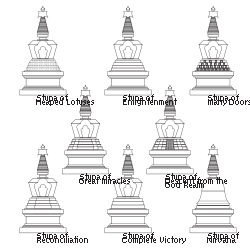
Tibetan Buddhism
Tibetan Buddhism is the body of Buddhist religious doctrine and institutions characteristic of Tibet and certain regions of the Himalayas, including northern Nepal, Bhutan, and India . It is the state religion of Bhutan...
, each referring to major events in the Buddha
Gautama Buddha
Siddhārtha Gautama was a spiritual teacher from the Indian subcontinent, on whose teachings Buddhism was founded. In most Buddhist traditions, he is regarded as the Supreme Buddha Siddhārtha Gautama (Sanskrit: सिद्धार्थ गौतम; Pali: Siddhattha Gotama) was a spiritual teacher from the Indian...
's life.
Lotus Blossom Stupa
Also known as Stupa of Heaped Lotuses or Birth of the Sugata Stupa, this stupa refers to the birth of the BuddhaGautama Buddha
Siddhārtha Gautama was a spiritual teacher from the Indian subcontinent, on whose teachings Buddhism was founded. In most Buddhist traditions, he is regarded as the Supreme Buddha Siddhārtha Gautama (Sanskrit: सिद्धार्थ गौतम; Pali: Siddhattha Gotama) was a spiritual teacher from the Indian...
. "At birth Buddha took seven steps in each of the four directions" (East, South, West and North). In each direction lotuses sprang, symbolizing the Four Immeasurables: love, compassion, joy and equanimity. The four steps of the basis of this stupa is circular, and it is decorated with lotus-petal designs. Occasionally, seven heaped lotus steps are constructed. These refer to the seven first steps of the Buddha.
Enlightenment Stupa
Also known as the Stupa of the Conquest of MaraMara (demon)
In Buddhism, Māra is the demon that tempted Gautama Buddha by trying to seduce him with the vision of beautiful women who, in various legends, are often said to be Mara's daughters. In Buddhist cosmology, Mara personifies unwholesome impulses, unskillfulness, the "death" of the spiritual life...
. This stupa symbolizes the 35-year-old Buddha
Gautama Buddha
Siddhārtha Gautama was a spiritual teacher from the Indian subcontinent, on whose teachings Buddhism was founded. In most Buddhist traditions, he is regarded as the Supreme Buddha Siddhārtha Gautama (Sanskrit: सिद्धार्थ गौतम; Pali: Siddhattha Gotama) was a spiritual teacher from the Indian...
's attainment of enlightenment under the bodhi tree in Bodh Gaya, where he conquered worldly temptations and attacks manifesting in the form of Mara.
Stupa of Many Doors
Also known as the Stupa of Many Gates. After reaching enlightenment, the Buddha taught his first students in a deer-park near SarnathSarnath
Sarnath or Sārnātha is the deer park where Gautama Buddha first taught the Dharma, and where the Buddhist Sangha came into existence through the enlightenment of Kondanna. Sarnath is located 13 kilometres north-east of Varanasi, in Uttar Pradesh, India...
. The series of doors on each side of the steps represent the first teachings: the Four Noble Truths
Four Noble Truths
The Four Noble Truths are an important principle in Buddhism, classically taught by the Buddha in the Dharmacakra Pravartana Sūtra....
, the Six Perfections, the Noble Eightfold Path
Noble Eightfold Path
The Noble Eightfold Path , is one of the principal teachings of the Buddha, who described it as the way leading to the cessation of suffering and the achievement of self-awakening. It is used to develop insight into the true nature of phenomena and to eradicate greed, hatred, and delusion...
and the Twelve Links in the Chain of Dependent Origination
Twelve Nidanas
The Twelve Nidānas are the best-known application of the Buddhist concept of pratītyasamutpāda , identifying the origins of dukkha to be in tanha and avijja...
.
Stupa of Descent from the God Realm
At 42 years old, Buddha spent a summer retreat in TushitaTushita
' or Tusita is one of the six deva-worlds of the Kāmadhātu, located between the Yāma heaven and the heaven. Like the other heavens, is said to be reachable through meditation...
Heaven, where his mother had taken rebirth. In order to repay her kindness he taught the dharma to her reincarnation. Local inhabitants built a stupa like this in Sankasya in order to commemorate this event. This stupa is characterized by having a central projection at each side containing a triple ladder or steps.
Stupa of Great Miracles
Also known as Stupa of Conquest of the TirthikaTirthika
Tirthika is a general term referring to adherents Jainism...
s. This stupa refers to various miracles performed by the Buddha when he was 50 years old. Legend claims that he overpowered maras and heretics by engaging them in intellectual arguments and also by performing miracles. This stupa was raised by the Lichavi
Licchavi
Licchavi was an ancient kingdom in Nepal, which existed in the Kathmandu Valley from approximately 400 to 750. Centuries earlier, at the start of the Buddhist era a powerful republic known as Licchavi existed in what is today Bihar. There is no conclusive evidence of any ethnic or historic links...
kingdom to commemorate the event.
Stupa of Reconciliation
This stupa commemorates the BuddhaBuddha
In Buddhism, buddhahood is the state of perfect enlightenment attained by a buddha .In Buddhism, the term buddha usually refers to one who has become enlightened...
's resolution of a dispute among the sangha
Sangha
Sangha is a word in Pali or Sanskrit that can be translated roughly as "association" or "assembly," "company" or "community" with common goal, vision or purpose...
. A stupa in this design was built in the kingdom of Magadha
Magadha
Magadha formed one of the sixteen Mahājanapadas or kingdoms in ancient India. The core of the kingdom was the area of Bihar south of the Ganga; its first capital was Rajagriha then Pataliputra...
, where the reconciliation occurred. It has four octagonal steps with equal sides.
Stupa of Complete Victory
This stupa commemorates Buddha's successful prolonging of his life by three months. It has only three steps, which are circular and unadorned.Stupa of Nirvana
This stupa refers to the death of the BuddhaGautama Buddha
Siddhārtha Gautama was a spiritual teacher from the Indian subcontinent, on whose teachings Buddhism was founded. In most Buddhist traditions, he is regarded as the Supreme Buddha Siddhārtha Gautama (Sanskrit: सिद्धार्थ गौतम; Pali: Siddhattha Gotama) was a spiritual teacher from the Indian...
, when he was 80 years old. It symbolizes the Buddha's complete absorption into the highest state of mind. It is bell-shaped and usually not ornamented.
Kalachakra stupa
A 9th kind of stupa exists; the Kalachakra stupa. Its symbolism is not connected to events in the Buddha's life, but instead to the symbolism of the Kalachakra Tantra, created to protect against negative energies.Regional names
Regional names for stupa include:- ChaityaChaityaA chaitya is a Buddhist or Jain shrine including a stupa. In modern texts on Indian architecture, the term chaitya-griha is often used to denote assembly or prayer hall that houses a stupa.-History:...
(Nepal) - Candi (Indonesia and Malaysia)
- Chedi (Thailand [])
- Chorten [Tibet, Ladakh (India) and Bhutan] མཆོད་རྟེན༏ (WylieWylie transliterationThe Wylie transliteration scheme is a method for transliterating Tibetan script using only the letters available on a typical English language typewriter. It bears the name of Turrell V. Wylie, who described the scheme in an article, A Standard System of Tibetan Transcription, published in 1959...
: mchod rten), "support for offering/worship") - Dagoba / Chaitiya / chaitya / thupa / vehera / dagaba (Sri Lanka)
- Chedey (Cambodia)
- Phrathāt (Lanna)
- Havitta or ustubu (Maldives)
- Suburgan/Suvarga (Mongolia)
- Субурган (Russia)
- Tap (Korea [], from Chinese)
- Tháp (Vietnam [, from Chinese])
- Thart (Laos)
- Ta , ancient transliterationTransliterationTransliteration is a subset of the science of hermeneutics. It is a form of translation, and is the practice of converting a text from one script into another...
of Sanskrit stupa. - Sotoba (Japan [], Tō (Japan [], from Chinese)
- Zedi (Myanmar [Zedi ) /Pahto (])
- Setaow
- Tseti or Puhto
- Chedi (ThaiThai languageThai , also known as Central Thai and Siamese, is the national and official language of Thailand and the native language of the Thai people, Thailand's dominant ethnic group. Thai is a member of the Tai group of the Tai–Kadai language family. Historical linguists have been unable to definitively...
: เจดีย์, from the Pāli cetiya (चेतिय) - Chedi (TamilTamil languageTamil is a Dravidian language spoken predominantly by Tamil people of the Indian subcontinent. It has official status in the Indian state of Tamil Nadu and in the Indian union territory of Pondicherry. Tamil is also an official language of Sri Lanka and Singapore...
or Thoopam - Chedi Sinhalese: චෛත්යයය)
- dāgaba (usually spelled "Dagoba") (Sinhalese: දාගැබ, from Sanskrit dhātu-garbha (दातु-गर्भ) "relic-chamber" )
- tope (HindiHindiStandard Hindi, or more precisely Modern Standard Hindi, also known as Manak Hindi , High Hindi, Nagari Hindi, and Literary Hindi, is a standardized and sanskritized register of the Hindustani language derived from the Khariboli dialect of Delhi...
: स्तूप, from the Sanskrit) - garbha (Sanskrit: गर्भ, meaning a storehouse or repository)
- sotoba or sotōba (JapaneseJapanese languageis a language spoken by over 130 million people in Japan and in Japanese emigrant communities. It is a member of the Japonic language family, which has a number of proposed relationships with other languages, none of which has gained wide acceptance among historical linguists .Japanese is an...
: 卒塔婆, a transliteration of stupa, usually shortened as tō 塔)
See also
- Ancient stupas of Sri LankaAncient Stupas of Sri LankaThe stupa is considered an outstanding type of architectural creation of ancient Sri Lanka. Under the influence of Buddhism there occurred several changes in the field of architecture in Sri Lanka. The stupa commands a prominent place among these changes...
- CetiyaCetiyaThe cetiya, "reminders" or "memorials" , are objects and places used by Theravada Buddhists to remember Gautama Buddha. These are traditionally divided into three categories: śarīraka, pieces of the body, paribhogaka, things he used, and udeśaka, reminders...
- ChaityaChaityaA chaitya is a Buddhist or Jain shrine including a stupa. In modern texts on Indian architecture, the term chaitya-griha is often used to denote assembly or prayer hall that houses a stupa.-History:...
- GorintōGorintois the name of a Japanese type of Buddhist pagoda believed to have been first adopted by the Shingon and Tendai sects during the mid Heian period. It is used for memorial or funerary purposes and is therefore common in Buddhist temples and cemeteries. It is also called or , where the term sotoba...
- Great Stupa of Universal CompassionGreat Stupa of Universal CompassionGreat Stupa of Universal Compassion is a Buddhist stupa currently under construction near Bendigo, Victoria, Australia. It will be the home of the Jade Buddha for Universal Peace, once the Stupa is complete and when the Jade Buddha has finished its world tour....
- HōkyōintōHokyointoA is a Japanese pagoda, so called because it originally contained the sūtra. A Chinese varianto of the Indian stūpa, it was originally conceived as a cenotaph of the King of Wuyue - Qian Liu.- Structure and function :...
- Mankiala Stupa
- PagodaPagodaA pagoda is the general term in the English language for a tiered tower with multiple eaves common in Nepal, India, China, Japan, Korea, Vietnam and other parts of Asia. Some pagodas are used as Taoist houses of worship. Most pagodas were built to have a religious function, most commonly Buddhist,...
- Peace PagodaPeace PagodaA Peace Pagoda is a Buddhist stupa designed to provide a focus for people of all races and creeds, and to help unite them in their search for world peace. Most have been built under the guidance of Nichidatsu Fujii , a Buddhist monk from Japan and founder of the Nipponzan-Myōhōji Buddhist Order...
Notations
- Mitra, D. (1971). Buddhist Monuments. Sahitya Samsad: Calcutta. ISBN 0-89684-490-0.

